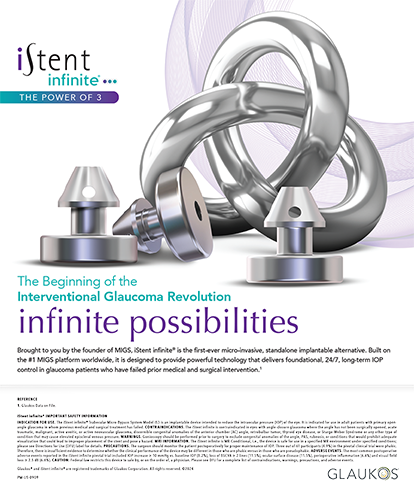Bimanual phaco has actually been around for a long time; Steve Shearing, MD, wrote about it almost 20 years ago. The primary concern with ultrasound has always been the risk of wound burn. Until recently, it has been necessary to use an irrigating sleeve around a bare needle to decrease its heat. This and other issues regarding irrigation and aspiration were what prompted me to explore bimanual phacoemulsification. I thought that by separating irrigation from aspiration, we might be able to enhance the safety, efficacy, and efficiency of this procedure.
I believe that the improvement in I/A is the most important aspect of bimanual phacoemulsification right now. In the future, lenses will be able to be inserted through smaller incisions, and this may advance the technology very rapidly. Bimanual phacoemulsification offers several other advantages, including the ability to switch from one wound to the other in the event of a complication or a difficult region. Another advantage is that it eliminates the subincisional cortex; surgeons have performed bimanual I/A after nucleus removal just for that reason. Using bimanual phacoemulsification, I hope to prove that we can significantly lower the complication rate.
Incision Sizes
I do not believe that the further reduction in incision size affects patients' visual outcomes at all. I still create a 2.8-mm wound to insert the lens, and I see the same astigmatism shift. A potential advantage of this technique would be the ability to insert the IOL through a microincisional wound. However, surgeons must show that there are advantages to smaller wound sizes. For instance, I believe that our current sutureless, 3.0-mm incisions are creating more endophthalmitis than in the past, and I believe that stab incisions would eliminate that concern. It is difficult to gauge how important microphaco is going to be, and I do not think it is for all surgeons right now. There are, however, a significant handful of early adopters and innovators who are now promoting it. I feel that I have been able to show that microphaco with a bimanual technique will work on the hardest of cataracts, but we must go further and show that it has very real advantages.
Finer Points
It is important to note that the incision sizes should be the same for both the phaco needle and the chopper. There are technologies available in which the incision sizes are not the same, but the ability to interchange instruments, either the irrigation and aspiration instruments, the phaco needle, or the irrigating second instrument, is a huge advantage. Having identical wound sizes enables surgeons to freely interchange all of these instruments.
Bimanual phaco also requires that adjustments be made in vacuum and flow settings. There is less inflow with bimanual phacoemulsification compared to traditional phacoemulsification, and therefore, lower aspiration flow rates are recommended. It turns out that the surgeon does not short-circuit the flow as in coaxial phacoemulsification; I typically use 20 to 22 mL of aspiration flow, and I lower my maximum vacuum level somewhat to limit surge—250 mm Hg is as high as I prefer to go.
Bimanual phacoemulsification probably offers less control compared with standard phacoemulsification, because of the limits on flow and vacuum parameters. However, the reduction in control is not profound. As long as the phaco needle stays well away from any internal structure that it could damage, I think surgeons can effectively show that bimanual phacoemulsification is safer.
One challenge that surgeons may find with bimanual phaco is that the irrigating chopper must be correctly positioned within the eye at all times in order to maintain the proper inflow. This has not been an issue for me, because I have always been a very aggressive two-handed phaco surgeon. People who are strongly one-handed may find that they are happier utilizing an anterior chamber maintainer, and in that way would not need to use a second irrigating instrument. These surgeons could just have a small stab incision to insert instruments when necessary. Surgeons who dislike having a second hand there all the time, however, may not like this technique.
For First-Timers
For those surgeons who wish to try bimanual phaco, I do not suggest attempting the procedure using more than two incisions, because of the risk of leakage and poor chamber maintenance. I suggest that surgeons make two stab incisions after ensuring that they are familiar with the parameters and the safety of the system they are using. I consider any ultrasound technology to be safe, as long as surgeons use it sparingly, and minimize the use of continuous phaco energy. If surgeons tend to use a lot of continuous energy, then I would choose the system carefully. Beginning bimanual surgeons should leave enough room between the two stab incisions to permit a new 2.8 or 3.0-mm incision to be made just in case. If they become uncomfortable with the bimanual technique, they can resume coaxial phaco through this fresh incision.


